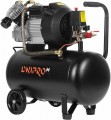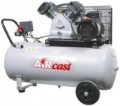Drive
The method of transferring rotation from the motor shaft to the working mechanism of the compressor.
— Straight. In
direct drive compressors, the operating mechanism shaft is aligned directly with the motor shaft — therefore, such models are also called coaxial. Their main advantage is the low cost due to the simplicity of the design, as well as the small dimensions of the compressor unit. However, this simplicity does not extend to repairs: it is likely that even with a small malfunction, you will have to disassemble most of the device. In addition, this option is characterized by a high level of noise, and the speed of rotation of the shaft is quite high, which greatly wears out the working mechanism. It is very difficult to create a high-performance compressor based on a direct drive, because design features adversely affect cooling efficiency. Therefore, such models usually belong to entry-level devices with low performance.
—
Belt. The operation of this drive is based on the use of two pulleys (one on the motor shaft, the other on the shaft of the working mechanism) connected by a drive belt. It is more bulky, somewhat more complex in design and more expensive than a straight line, but outperforms it in a number of other indicators. First of all, this is performance: separately located engine and working mechanism is much easier to cool, which allows you to create compressors of almost
...any capacity without the risk of overheating. In addition, due to the difference in the diameter of the pulleys, the speed of rotation of the shaft of the working mechanism is lower than that of the engine, which further reduces heating and has a positive effect on the resource. Belt-driven compressors are easy to repair and maintain (due to the ability to access the engine and mechanism separately), and their noise level is low.Rated pressure
The maximum pressure created by the compressor during operation. This parameter, as well as the performance described above, is very important for selecting a compressor for a specific pneumatic tool: it is necessary that the nominal pressure be not lower than the working pressure of the tool. At the same time, high pressure is not a problem — it can be reduced by the appropriate regulator on the gearbox.
Most modern compressors have a
pressure rating of 8 bar, which is sufficient for most air tools. Units for 6 bar belong to the entry level, their main purpose is painting work, where high pressure is not required. There are also options for 10 bar and even more — they, usually, belong to specialized models and cost accordingly. Therefore, it is worth looking specifically for a high-pressure unit only if this parameter is critical for the planned work (for example, if you need a compressor for tyre fitting).
When selecting according to the nominal pressure, it must be taken into account that the maximum allowable pressure in the receiver is usually indicated as the nominal pressure. The pressure actually given out by the compressor to the outlet is often somewhat less, this is due to some design features. For the most popular nominal pressure options — 8 and 10 bar — the real figures are usually 2 bar less, i.e. 6 and 8 bar respectively.
Rotation speed
The speed of rotation of the compressor motor shaft in normal operation. This parameter, usually, does not affect the efficiency of the unit — the main indicators are still the performance and nominal pressure (see above). At the same time, it allows you to evaluate the design features of the compressor and its durability. The fact is that a higher rotation speed allows the use of fairly simple and inexpensive working mechanisms, but it increases the wear of moving parts and reduces the motor resource. Therefore, a model with a lower number of revolutions is likely to cost more than the "high-speed" version, but it will also last longer (ceteris paribus characteristics — performance, pressure, drive type, design; see all above).
Power source
Among the power sources in compressors are
the electrical network,
batteries,
gasoline and
diesel. A different section is provided for classic automobile compressors, but there are also reputable
compressors powered by 12 V. More details about each of them:
—
Electrical network (230 V). The most popular power source used in modern compressors. Electric motors have relatively small dimensions and weight, and during operation they create significantly less noise than internal combustion engines and do not produce exhaust gases, making them safe even with poor ventilation in the room. In addition, they are easy to operate and do not require refueling, expensive starting equipment or complex procedures. The only significant drawback worth noting is the need for an external power source - if it is impossible to connect electricity, a compressor with an electric motor will be absolutely useless. Power supply from a 230 V network with single-phase alternating current limits the models in terms of power and such devices can be classified as household rather than professional.
—
Electrical network (400 V). Powered by a three-phase (three pairs of contacts “zero” – “phase”) network with a voltage of 400 V. Such a network can be conditi
...onally called “industrial”: it is not used in everyday life, but is widespread in industrial premises such as workshops, workshops, car repair bays and so on. The main advantage of this type of power supply is high power, which allows you to create compressors with high pressure and performance. At the same time, there is no point in producing low-power units for only 3 phases - the main advantage is lost, and the disadvantage of incompatibility with 230 V networks (and, accordingly, a limited scope of application) remains. Therefore, 400 V power supply is exclusively the prerogative of high-power compressors intended for professional use. Before purchasing such a device, you must make sure that there is a three-phase connection at the location of the planned installation.
— Battery. Powered by its own battery. The main advantages of this option are mobility, the ability to work independently of outlets and the absence of a power cord that can interfere with work. On the other hand, such power supply is not suitable for high power; all other things being equal, a cordless tool turns out to be noticeably heavier and more expensive than a mains one, and the operating time is limited by the battery charge. However, in most cases the battery is removable, which allows you to keep several batteries ready and change them as needed.
- Gasoline. An internal combustion engine (ICE) using gasoline as fuel. Such compressors are indispensable if you have to work in places without access to electricity: gasoline engines do not depend on external power sources, are completely autonomous and can operate as long as there is fuel in the tank. On the other hand, they are more expensive than electric ones (both on their own and in operation, due to the high cost of gasoline), weigh more, make more noise, are difficult to start and require certain maintenance skills. In addition, exhaust gases create serious inconvenience and limit the use of internal combustion engines - when working indoors, good ventilation is necessary. As a result of all this, compressors with gasoline engines are more of a backup option in case it is impossible to use an electric motor, and they are not widely used.
— Diesel. An internal combustion engine running on diesel fuel. It is characterized by all the same basic features as the gasoline one (see above), but there are some differences. The most striking thing is that diesel engines are generally more expensive than gasoline engines, but they have a longer service life and are cheaper to operate due to the relatively low price of fuel.
— Electrical network 12 V. The compressor can be connected to the vehicle network as power supply.Noise level
The maximum noise level produced by the compressor during operation. When evaluating it, it must be taken into account that the decibel used to evaluate noise is not an absolute value. In fact, this means that noises, for example, 20 dB and 40 dB differ in level not by a factor of 2, but by 100 — it is this multiplicity that corresponds to a difference of 20 dB; a twofold increase corresponds to a 3 dB increase. Therefore, to assess noise levels, it is worth referring primarily to comparative tables. For values found in modern compressors, this table would look something like this:
70 dB — loud conversations at a distance of about 1 m;
75 dB — scream;
80 dB — motorcycle engine with silencer;
85 dB — loud scream;
90 dB — freight train car at a distance of 5-7 m;
95 dB — noise inside the subway car.
Anyway, the lower the level of noise produced by the unit, the more comfortable its use, the less it will “hit on the ears” and increase the volume of the entire set of working instruments.
Noise level (LPA)
The sound pressure level in decibels at a certain distance between the noise source and the ear of the compressor equipment operator. Since people do not work in the immediate vicinity of the compressor, the parameter will be useful for estimating the noise level at a distance. It is most often measured at a distance of 7 m from a working installation, less often at a distance of 1 m.

